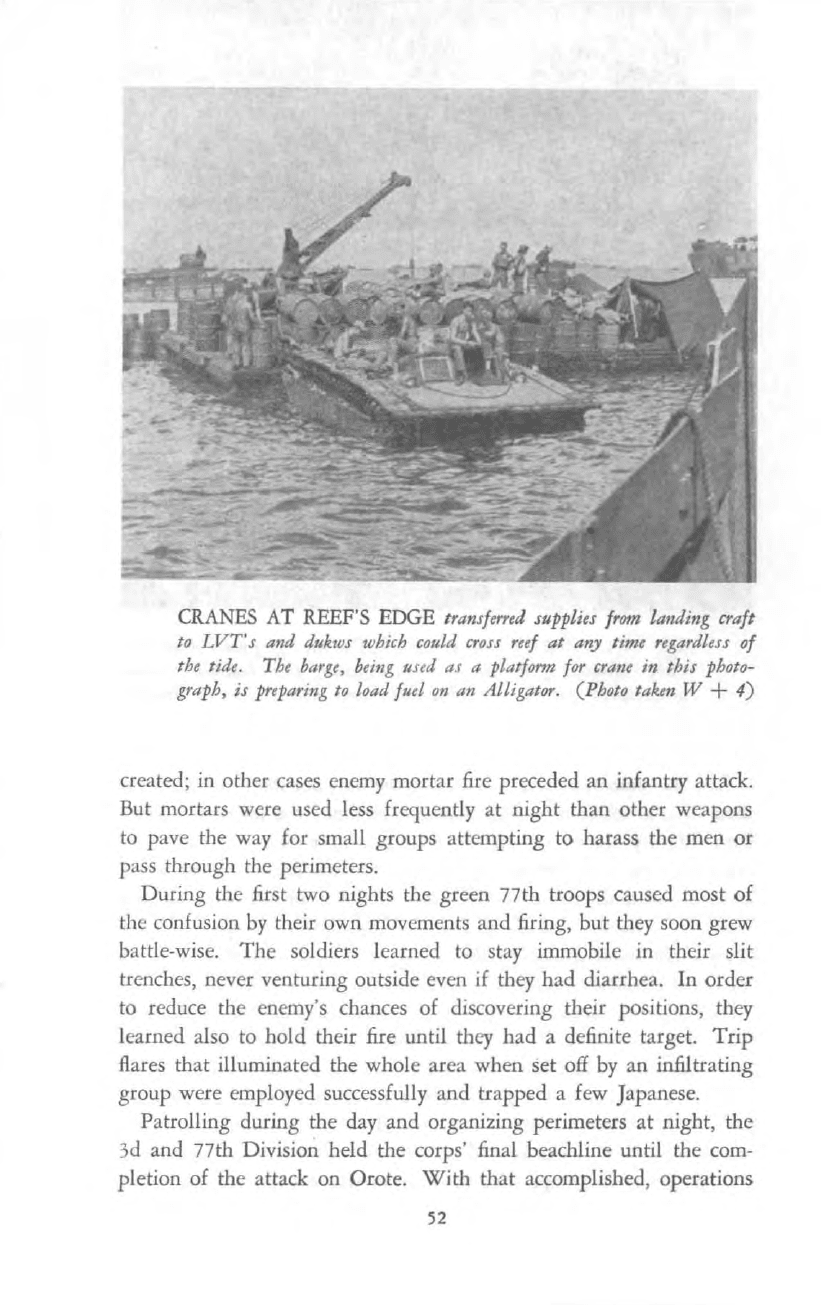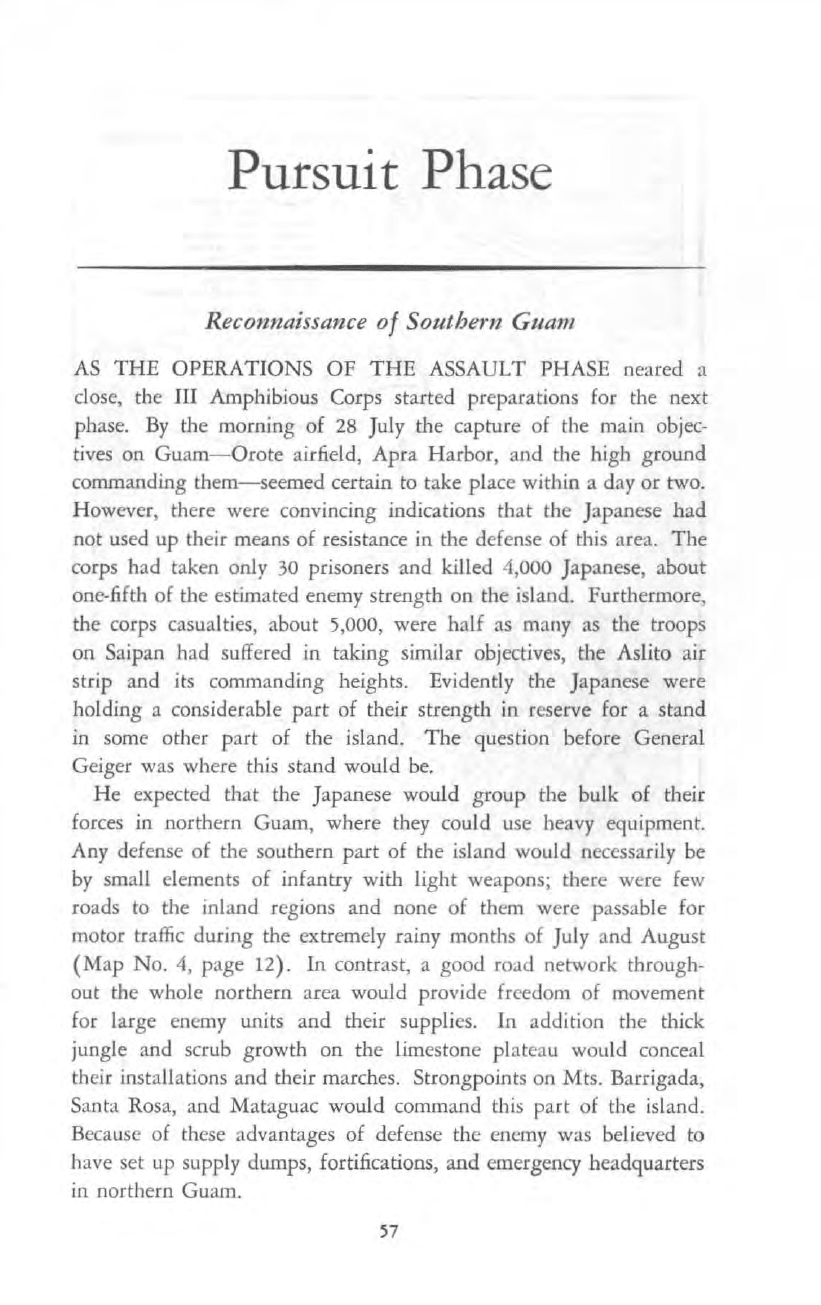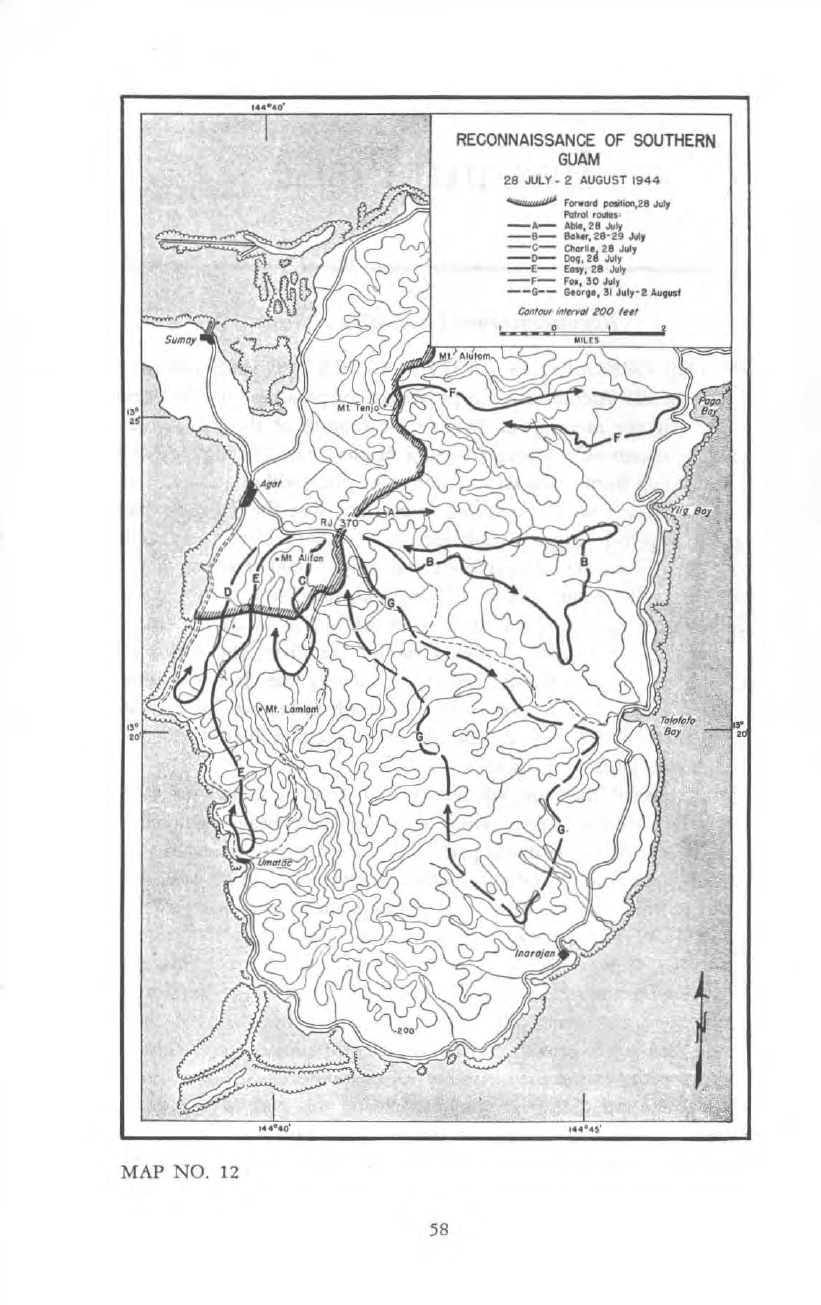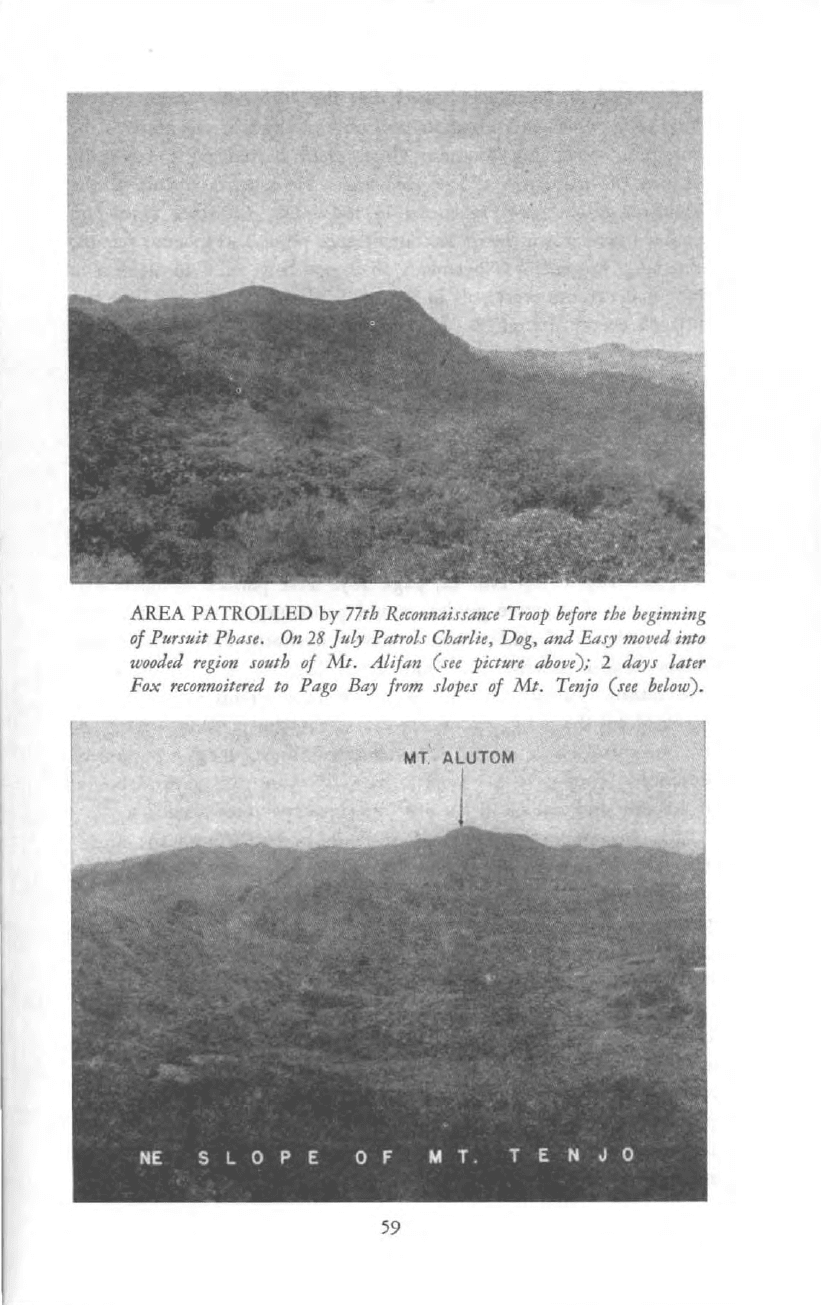Guam: Operations of the 77th Division, 21 July - 10 August 1944 (ENG)
Подождите немного. Документ загружается.


MEN
OF
COMPANY B
of
the
J05th
R.eT
on
th,
high
ground
abo., Agat
beach.
Elements
of
fhil
company,
in
defmdillg fillal beach/int,
formed
reconnaissance
patrol! that threatened
enemy
with large-Ieale attncJu.
Division patrols were active during the day, but they stayed within
their lines at night, when the Japanese assumed the initiative. After
dark infantry companies on the final beachline organized battalion
perimeters on high points, arranging automatic fires to cover lower
areas between the perimeters. Although fields
of
fire were cleared
wherever possible and commanding ground was occupied, nearly
every night small groups of the enemy employed skillful infiltration
tactics to penetrate the line.
The
Japanese seemed to follow no standard plan for infiltration.
They used a variety of
weapons-mortars,
small arms, sabers, and
even hatchets. Sometimes the first evidence of the enemy was a
grenade thrown into the perimeters; sometimes an enemy soldier
in
plain sight slow
ly
walked toward the division's lines; occasionally,
heavy
fire
and grenades landed in the positions along the perimeter,
and small enemy groups tried
to move in where confusion had been
51

CRANES AT REEF'S EDGE trans/,md supplies
from
landing craft
to
LVT'I
and JukwJ which
cOf~1d
cross
,etf
at
allY time regardlen
of
the tide. The
barge
J being used
al
II
platform for cratle
i1J
this
photo-
$raph, is
preparing
to
load fu,l
011
all
AlIi$ator. (Photo
taken
W +
4)
created;
in
other cases enemy mortar lire preceded an infantry attack.
But mortars were used
less
frequently at night than other weapons
to
pave the way for small groups attempting to harass the men or
pass through the perimeters.
During the first two nights the green 77th troops caused most of
the confusion
by
their own movements and liring, but
tlley
soon grew
battle-wise. The soldiers learned
to
stay immobile in their slit
trenches, never venturing outside even
if
they had diarrhea. In order
to
reduce the enemy's chances of discovering their positions, they
learned also to hold their
lire until they had a delinite target. Trip
flares
that illuminated the whole area when set
off
by
an in.filtrating
group were employed successfully and trapped a few Japanese.
Patrolling during the
day
and organizing perimeters at night, the
3d and 77th Division held the corps'
linal beacbline until the
com-
pletion of the attack on Orote. With that accomplished, operations
52

of the assault phase ended.
The
corps, during this
10
-day phase, had
gained Apra Harbor, which was found to be in excellent cnndition,
and
Orate airlield, which was already being used for emergency
landings. The assault operations had cost the
III
Amphibious Corps
5,987
cas
ualties, mostly in the marine units.
Of
this number 958
were
killed, 4,739 wounded, and 290 missing.
The
77th Division,
engaged
in
holding its sector
of
the linal beachline, lost 217 men.
Battle of Supply
The reef that had kept the landing craft of the assault troops from
getting
to
tl,e shore was also a barrier
to
the supply boats, no matter
how high the tide. However,
III
Amphibious Corps had planned
on
transferring supplies
at
the reef's edge
to
smaller vehicles and had
carried equipment for mooring ponton barges and causeways
off
the
reef. Twenty-live light cranes, mounted on the barges, were to be
used
to
transfer cargo from the LCVP's (Landing Craft, Vebicle,
Personnel) and LCM's
to
dul.-ws
and LVT's, which
in
turn would
carry the cargo across the reef
to
the beach. LST's were
to
beach
against the reef, drop their ramps, and be unloaded by dukws
and LVT's.
At
lirst supplies were loaded into LVT's and dukws in the transport
area. During the
lirst few days, the dukws moved cargo from tl,e
ships directly
to
dumps inland. After tbe beaches were secure, the
plans for direct transfer of supplies from LST's
to
dukws and LVT's
at
the reef's edge were
put
into effect. Numerous other expedients
were used
to
get the 77th's supplies ashore.
The
division borrowed
cranes, ponton barges, and LVT's from marine and navy units.
Supplies were even floated ashore on life rafts from transports and
on lO-man rubber boats whicb had been brought along for the use
of
tl,e Reconnaissance Troop.
The
60
dukws
of
the division were
pooled and operated under
G-4
control.
An
officer on each of the
six crane barges used
by
the division supervised operations with
walkie-talkie radio communication ashore.
The
77th Division
com-
mand or regimental commands ordered certain supplies or equipment
from supply officers; shore personnel informed the officers on the
crane barges of the desired cargo, and these officers in turn directed
that cargo ashore to the requested are
a.
53

BULLDOZERS CLEARED ROADS
to
b,ach dumps
for
th,
track<d
amphihious vehicles which ctI"ieti the supplies from the
reef
to
storage
and
diJpersal areas
011
.fhore.
Along the reef
(at
center) IJ crane
loads a
tractor~'
tbe transport ships
are
anchored farther out to
.rea.
Unloading was not accomplished without difficulties. Jeeps and
other vehicles driven ashore drowned out even
at
low tide. The
dumps, selected before the landing from maps and photographs,
were limited in area, and many were located on marshy lowland
where little satisfactory storage space existed. Tropical rains and
constant grinding traffic produced a sea
of
mud on the roads to
the dumps. Tracked movers sometimes took 3 hours to make a
round trip from the beach
to
the
dumps-a
distance in most cases
of only
600 yards. Wheeled vehicles repeatedly bogged down and
had
to
be towed out
by
tractors.
To
keep beach roads and dump
areas in operating condition, some
of
the shore party had to be
diverted from unloading and storing supplies.
Because of these conditions it became clear fairly early that the ships
of the 77th Division could not be unloaded
on
a dawn-to-dark basis

only. Fortunately, since the enemy seemed unable
to
produce aIr
support or
to
lay artillery
fire
on the bea
ch
es, it was possible
to
illuminate the beaches
at
night. Floodlights powered
by
generator
units of the shore parties enabled work
to
proceed
on
a 2
4-
hour
basis. This expedient enabled the
APA's (Transport, Attack) to be
80 percent unloaded
by
the end of the fifth day.
Landing supplies on this 24-hour basis imposed a tremendous
strain on men and equipment.
Of one group of
20
dukws working
on Agat beach, 6 were out of commission
at
th
e end of the
fir
st day
of unloading operations (chiefly from bent screws, damaged rudders,
bent propeller shafts, and burned-out propeller shaft bearings) , 2
more the following day, and 6 more on the next.
The
men worked
with little rest or sleep; their food consisted of the regular combat
rations.
SUPPLYING THE 77TH DIVISION
over
.. t
h,
t
ou$hes
t
reef
ill
,his
war" was a mojor operat
ion
. Photo Jhollls the
Jeve
r,
J
lr
ai
l~
on e
qu
i
pm
mt.
. . .
-
--
55

RCT's operated the dumps until
24
July.
On
Agat beach the Corps
Service Group, which had landed on
23
July, relieved the brigade
of supply responsibilities.
The
brigade had maintained the 77th
Division
on
marine stock for three days. On W +
7,
after a week
of clear weather and calm, the 3d Marine Division and the 1st
Provisional Marine Brigade had all their supplies ashore.
The
77th
Division completed its unloading on W
+ 10, except for two
com-
mercially packed ships.
By
the time the assault phase was over, the units had ashore an
ade9uate store of
materiel.' Food, clothing and eguipment, fuels
and lubricants (Classes I, II, and III) were available in amounts
sufficient for 20-days' supp
ly
. Only hard work and numerous field
expedients had kept supply on schedule for the battles ahead. A
naval
office
r, veteran of Guadalcanal, Attu, Tarawa, Kwajalein, and
Saipan wrote
to
General Bruce, "Your people landed and supplied
themselves over the toughest reef yet worked
by
any outfit in this
war,"
I Of the
five
classes
of
supplies for
the
77th Division, Class I was initially
of
most
importance. The
"
IO
·in·l" ration
pack.
seven days' type
"C,"
three days' type "K,"
twenty
days'
supply
of
ration accessories.
and
other special types were landed. Water
was carried on transports
at
the level
of
two galJons per
man
per day, making a total
of
190,000 gallons (or the division carried
in
5-gallon
and
:55-gallon drums. Most
of
this supply was brought ashore, but the early establishment
of
distillation units on the
beach enabled the 77th
to
keep some
of
its water
in
reserve.
Clothing
and
equipment made up Class
II
materiel. Clothing alone amounted to
tremendous bulk because the division
was required
to
carry
impregnated protective
clothing for all its men.
The
division developed a standard roll in
an
attempt
to
supply the troops without having
to
segregate rolls
by
companies
and
individuals.
However, owing
to
transportation difficulties these were never delivered
to
the troops.
This
roll
consisted
of
a shelter half, one blanket, mosquito
bar,
one "K" ration, cake
of salt water soap,
pack
carrier, tent pole, five pins, a pair
of
mosquito gloves, and a
waterproof clothing bag.
Class
III
supplies were packed in
~-gallon
and
'~-gallon
containers,
and
in
~5-pound
pails for heavy gear lubricants.
It
was necessary
to
carry
aviation gasoline for the
liaison planes; leaded gasoline
and
diesel oil for trucks, tractors,
and
tanks; white
gasoline for kitchens;
and
a variety
of
weights
of
engine oils
and
gear lubricants.
Class
IV
supplies consisted mainly
of
engineer and chemical warfare equipment.
Approximately
22,
tons
of
engineer items
were
carried, including fortification materials
such
as
barbed
wire, pickets,
and
sandbags.
Heaviest
of
all were Class V supplies, loaded at the level
of
ten units
of
fire
for
antiaircraft weapons
and
seven
Wlits
of
rue
for all others.
The
magnitude
of
this class
of
supplies
can
be
seen from the fact that the 77th used 46,000 hand grenades alone
in
the operation.

Pursui t Phase
Rec01l1zaissance
of
Southern Guam
AS
THE
OPERATIONS OF
THE
ASSAULT PHASE neared a
close, the III Amphibious Corps started preparations for the next
phase.
By
the morning of
28
July the capture of the main objec-
tives on Guam- Orote airfield, Apra Harbor, and the high ground
commanding them
-see
med certain
to
take place within a day or two.
However, there were convincing indications that the Japanese had
not used up their means of resistance in the defense of this area. The
corps had taken only
30
prisoners and killed 4,000 Japanese, about
one-fifth of the estimated enemy strength on the island. Furthermore,
the corps casualti
es,
about 5,000, were half
as
many
as
the troops
on
Saipan had suffered in taking similar objectives, the Aslito air
strip and
its
commanding heights. Evidently the Japanese were
holding a considerable part of their strength in reserve for a stand
in some other part of the island.
The
question before General
Geiger was where this stand would
be.
He expected that the Japanese would group the bulk of their
forces in northern Guam, where they could use heavy equipment.
Any defense of the southern part of the island would necessarily be
by
sma
ll
elements of infantry with
li
g
ht
weapons; there were
few
roads
to
the inland regions and none of them were passable for
motor traffic during the extremely rainy months of July and August
(Map
No.4
, page 12). In contrast, a good road network through-
out the whole northern area would provide freedom of movement
for large enemy units and their supplies. In addition the thick
jungle and scrub growth on the limestone plateau would conceal
their installations and their marches. Strongpoints on Mts. Barrigada,
Santa Rosa, and Mataguac would command this part of the island.
Because of these advantages of defense the enemy was
bel
ieved
to
have set up supply dumps, fortifications, and emergency headquarters
in northern Guam.
57

,,'
~.
MAP NO.
12
58
RECONNAISSANCE
OF
SOUTHERN
GUAM
2:8
JULy.
2:
AUGUST
1944
~
F..-d
pcIIiIOI,28
Jutr
I'VIrvI._
,
-
A-
AbIt,
rs
July
- 8- &Obl',2'
·2
9"..,.
=~
g:.~'~
2!,JlAJ
-£-
EOIJ.
21 .My
-
f'
-
FOI
, 30oluly
--
G-
-
Gtor,.,
31
July-Z Au.,...!
CDnltIfH
~
ZOO
,",

AREA PATROLLED by 77th
Ree
o.maissa
n"
Tro
op
hefore
the heginning
of Pursu
it
Phase.
Oil
28
July Patr
oiJ
Charlie, Dog.
and
Easy moved into
wooded
region
south of
Mt.
Alifan
em
picture ahove); 2 days later
Fox
reconnoitered
to
Pa
go
Bay
fr
om
slopes of
MI
. Tenjo
em
helow).
MT. ALUTOM
59

Captured documents indicated that the 10th Independent Mixed
Regiment, which according to previous intelligence reports was the
only unit occupying southern Guam, had moved north from
th
e
vicinity of Inarajan
to
the Agana area. However, elements of the
regiment might have
remain~d
in the south,
or
other units had
perhaps gone down there. Reconnaissance pilots and lookout guards,
watching for enemy movements, had not been able
to
determine
how many troops were still in the south. Far more definite
informa-
tion on enemy strength
to
the east and south of the 77th Division's
beachhead was needed before an advance from the
linal beachline
could be started. Even scattered enemy groups,
in
position
to
attack
the III Corps right flank, might seriously endanger a maneuver
to
the east and north.
The mission of getting more intelligence about enemy strength
in
southern Guam fell to the 77th Reconnaissance Troop, which
would move out on foot and search the ridge south of Mt.
Aldan
to
Vmatac, and the eastern coastal area between Ylig Bay and
Talofofo
Bay
(Map
No.
12,
page 58) . Five patrols of about live
men each, with native guides, would penetrate six miles each way
snuth and east of Alifan into unknown territory. Patrols Able and
Baker would proceed east from Road Junction
370 to the coast
and return. Patrols Charlie, Dog, and
Easy
would move directly
south along the ridge. Routes were laid out
by
division command,
but the patrols were instructed that they could vary these if it seemed
desirable. They were
to
report in
by
radio every two or three hours
if possible and could call for artillery support if they needed it.
The assignment was a dangerous one, particularly so for green
troops. All indications were that the Japanese did not hold the
southern island in force, but they might have left behind strong
parties for missions of harrying the beachhead.
The
live-man patrols
of the 77th would have
to
match their wits with an enemy who was
noted for his ability in hide-and-seek warfare and who knew every
inch of the island.
The
patrols would lack the usual advantage of
U.S.
troops-enormous
lire
power-and
would be
at
the mercy of
any large enemy group. But they would benelit
by
a psychological
advantage which General Bruce had prepared
by
sending beachline
patrols
on
increasingly long trips during the previous week. These
had made little contact with the Japanese, and their reports were
reassuring.
60
